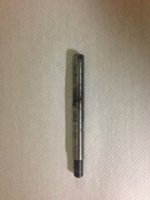In your repair manual there is a very good "How To" on clutch adjustment.
One important step most skip is to screw the handle bar adjustment in all the way before you start.
Then you adjust the side cover adjustment. To do this loosen the lock nut. Spin the screw out a few turns so you can spin it in /out a few times ti get a good feel for the amount of resistance to turn just the screw.
Once you get a good feel for this turn the screw in till you just feel an increase in the resistance. This is when all the free play between the adjuster screw and pressure plate have been removed. Any tighter and you will start to move the pressure plate, This is important because if you adjust it too tight you can cause slippage.
Once you get to this point you need to add a bit of free play to ensure complete closure of the pressure plate. The book calls for 1/4 turn back from this point, I have found it to be a bit much, I turn it back one flat of the lock nut. The nut will turn with the screw, as you turn it back just watch the flats on the nut, one flat is about right.
Now while holding the screw from turning snug the lock nut down, not too tight, just snug, you will want to be able to adjust this as the clutch wears.
Now up and the handle bar adjust the cable for about 1/8 inch free play. This gives you the max available pressure plate movement, while giving enough fre play to prevent slippage.
With a well lubed worm and good well lubed cable without any tight bends will give you as easy to pull lever and good clutch action. Well as easy as this design will give.
If your cable is rusty or worn even with proper lube it won't work well. There are good cables out there, Motion Pro is a good one, 650central has a good one, If you can find a Yamaha cable, they are good ones too. The one from Mike's XS may or may not be a good one. They had one once that had a heavy core but then they had one with a thin core that broke easily. If they ran out of the bad ones and have got in good ones then they may be ok.
One the XS400 1L9 worm the arm appears to be shorter than the XS650 units. This shorter arm mat increase the lever pull a slight amount but open the pressure plate farther. This improves clutch action.
The Worm unit Mike's sells Has a long arm but has two holes for mounting the cable holder. The hole farther out lessens the pull effort but won open the pressure plate as far.
The inner hole increases lever pull but opens the pressure plate farther.
The slight increase in lever pull is well worth the effort in the improvement in clutch action. The farther the pressure plate opens the less drag you have between the plates. This makes shifting easier as well as finding neutral.
Leo
 Guys,
Guys,